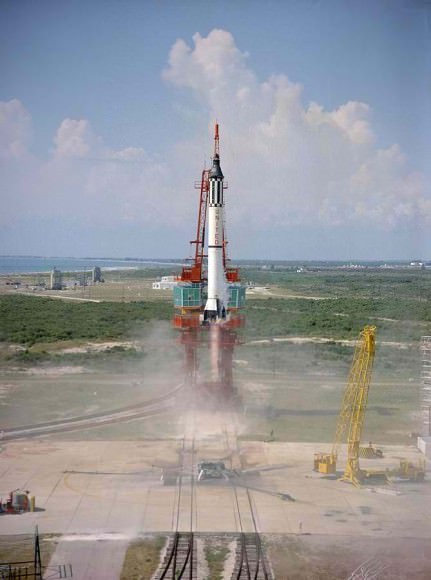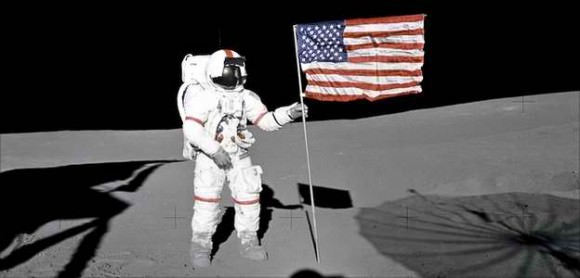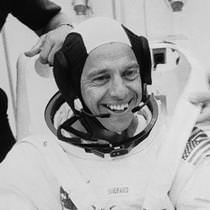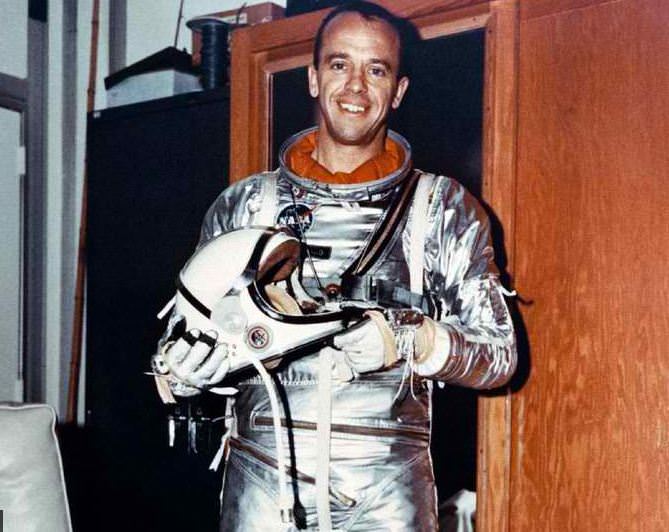[/caption]
50 years ago today, Alan Shepard blasted off on board the first flight of NASA’s Mercury program, becoming the first American in space. Shepard was the consummate astronaut, — he stayed with NASA for over 15 years, and eventually walked on the Moon. But for all his successes, Shepard was a complicated and conflicted man; even though he was in constant limelight along with all of the early NASA astronauts, his life was somewhat of an enigma, as he closely guarded his privacy and held most people – including his friends – at arm’s length.
“He was the epitome of the image that NASA had hoped to portray when they selected the first astronauts,” said Neal Thompson, author of the only Shepard biography, “Light This Candle: The Life and Times of Alan Shepard.” “He was a aircraft carrier pilot, a test pilot, drove fast cars, smoked cigars, drank martinis—he was stylish and cool and cocky. I’ve described him as Don Draper in a spacesuit. He represented that “Mad Men” era – cool and suave and all that.”
But, Thompson said, that was an image that Shepard worked hard to portray as well as protect, and Thompson felt there had to be more to Shepard’s story. Through years of research, Thompson found Shepard to be a much more compelling man than he ever expected.
“He wasn’t the most outgoing guy with the press and I felt like there had to be more to his story than what I had read,” Thompson told Universe Today. “There were a lot of aspects to his personality that were complicated and compelling and contradictory. He was highly competitive, but he was also a softy underneath at times. He was accused over the years of being a bit of a womanizer, and yet he was married to the same woman for 40-plus years and I think they were very devoted to each other. So there were a lot of complex aspects to his personality that were fun to explore.”
While all the other Mercury 7 astronauts had either written their own books or had books written about them, America’s first astronaut had not told his own life story, and no one had gotten close enough to tell it for him. Shepard died without ever authorizing a biography that focused on his life.

“I was really intrigued when I started researching his life that, no other biography had been written about him,” Thompson said.
The title of the book, which was first published in 2004, refers to Shepard’s impatience with NASA engineers who were making sure his Redstone rocket was ready to go. Shepard was frustrated: he knew very well he could have been the first human in space, if not for political and technical delays. But as it was, cosmonaut Yuri Gagarin launched on an orbital flight on April 12, 1961, becoming the first man in space and scoring a huge victory for the Soviet Union in the Cold War with the US.
23 days later, Shepard sat on the launchpad, waiting inside his rocket for over 4 hours while engineers tackled one problem and then another. The wait was longer than anyone expected and Shepard ended up having to urinate inside his spacesuit, claiming otherwise his bladder would burst.
Finally, when one more problem cropped up, Shepard exclaimed, “Why don’t you fix your little problem and light this candle?”
“I think that sums up his character in many ways, that one particular quote,” said Thompson. “He was a very intense guy who just wanted to get the job done and liked to move forward and not look back, and I think that reflection of that intensity of his personality is nicely summed in those few words.”

Shepard’s whole life was about competition. “Whether it was in sports as a youth, or competing among other naval aviators when he was a carrier pilot,” said Thompson, “and then it just sort of ramped up at each stage of his career, becoming a test pilot where he competed with some of the best aviators on the planet and then to be selected among this extremely elite group of Mercury 7 astronauts and then to compete against them for that first ride. But I think he thrived on that and it was fun to explore what that meant in the scope of the space program.”
Particularly intriguing to Thompson was the competitive relationship between Shepard and John Glenn, who early on were pegged as being the two astronauts who were most likely to fly first.
“As you know, Shepard was picked first and Glenn was furious about that,” Thompson said. “I think it is sort of interesting that now, historically, Glenn is more well known probably than Shepard, even though he was picked to fly third among the first astronauts. But because he has the orbital flight, Glenn’s flight is historically viewed as the bigger accomplishment.”
Shepard always kept a distance between himself and others. While he could be pulling a prank or making a joke one minute, the next he could be sullen and withdrawn or downright angry and unpleasant — which Thompson said was perhaps a way to keep the competition at bay.
But Shepard’s competitive nature is likely what made him so successful throughout his career, and in particular it was something he relied on in the mid-1960’s when he was grounded because of a disabling medical condition, Ménière’s disease, which causes severe vertigo and nausea, which is crippling for a pilot and astronaut.
“After his Mercury flight, he was selected to command the first Gemini mission, and while training for that was felled by Ménière’s disease,” Thompson said. “I think at that point, Shepard just considered hanging it up and leaving the space program and pursuing other things, like business or politics or something high profile.”
While Shepard could have anything he wanted — there were many offers he could have taken, Thompson said – he decided to stick with the program, to stay with NASA, to take on this lesser role as head of the astronaut office.
“It had to be really demoralizing for him to be the first American in space and then not be able to fly at all and to be stuck watching the other astronauts fly ahead of him. But it was always impressive to me that he did stick with it, he got his inner ear disorder cured, and fought his way back into the flight rotation and then was assigned to Apollo 14,” Thompson said.
But the disease may have saved his life from tragedy, as well. Shepard likely would have been chosen to lead Apollo 1 and was originally scheduled to command Apollo 13.

Thompson added that it says a lot about Shepard’s character that he managed to get assigned to command an Apollo mission and fly Apollo 14 so successfully.
Shepard stayed with NASA for 15 years which is longer than any of the other Mercury 7 astronauts, and longer than many astronauts today stay. “I think he really believed in the mission and believed in what he and what NASA was doing,” Thompson said.
What people might remember most about the Apollo 14 mission is Shepard hitting golf balls on the Moon.
“I think he viewed that as something that he wanted to do, maybe so that his flight could be remembered as being a little more unique than some of the others,” Thompson said. “It was a little bit of flair and maybe a sign of exuberance, punctuating his comeback and his successful flight, and he set things up so that he would only hit the golf balls at the end of the flight if everything went well. It was his kind of exclamation point tacked on to the end of Apollo 14 to say, “I did it” and here’s something fun and extra.”

Later Shepard was successful in business, becoming the first millionaire astronaut. “I think he enjoyed the rest of his life, business, traveling, playing golf, he loved his wife – he just lived a big life,” Thompson said.
Shepard died from cancer at age 74 in 1998. Tragically, his wife Louise died five weeks later from a heart attack during an airplane flight. It almost was if she couldn’t live without him.
“Shepard was almost larger than life – he always had that ‘little extra’ and he was an exceptional man at all levels,” Thompson said.
For more information: Neal Thompon’s website
Find the book “Light This Candle: the Life and Times of Alan Shepard” on Amazon.
You can listen to an interview I did with Thompson for the NASA Lunar Science Institute and 365 Days of Astronomy.

